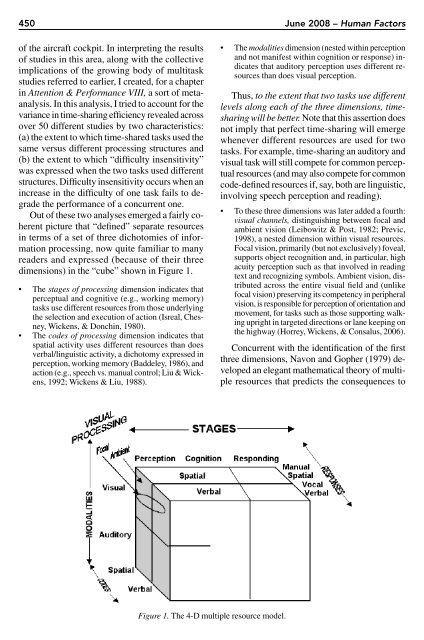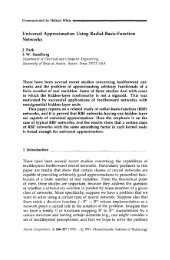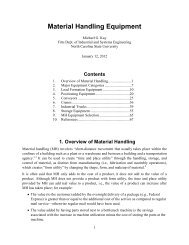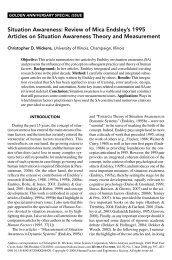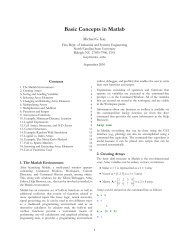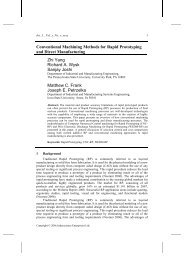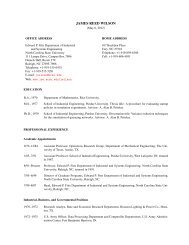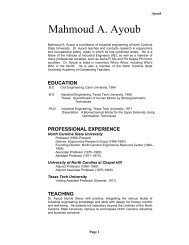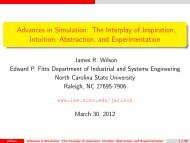Multiple Resources and Mental Workload - ResearchGate
Multiple Resources and Mental Workload - ResearchGate
Multiple Resources and Mental Workload - ResearchGate
Create successful ePaper yourself
Turn your PDF publications into a flip-book with our unique Google optimized e-Paper software.
450 June 2008 – Human Factors<br />
of the aircraft cockpit. In interpreting the results<br />
of studies in this area, along with the collective<br />
implications of the growing body of multitask<br />
studies referred to earlier, I created, for a chapter<br />
in Attention & Performance VIII, a sort of metaanalysis.<br />
In this analysis, I tried to account for the<br />
variance in time-sharing efficiency revealed across<br />
over 50 different studies by two characteristics:<br />
(a) the extent to which time-shared tasks used the<br />
same versus different processing structures <strong>and</strong><br />
(b) the extent to which “difficulty insensitivity”<br />
was expressed when the two tasks used different<br />
structures. Difficulty insensitivity occurs when an<br />
increase in the difficulty of one task fails to degrade<br />
the performance of a concurrent one.<br />
Out of these two analyses emerged a fairly coherent<br />
picture that “defined” separate resources<br />
in terms of a set of three dichotomies of information<br />
processing, now quite familiar to many<br />
readers <strong>and</strong> expressed (because of their three<br />
dimensions) in the “cube” shown in Figure 1.<br />
• The stages of processing dimension indicates that<br />
perceptual <strong>and</strong> cognitive (e.g., working memory)<br />
tasks use different resources from those underlying<br />
the selection <strong>and</strong> execution of action (Isreal, Chesney,Wickens,<br />
& Donchin, 1980).<br />
• The codes of processing dimension indicates that<br />
spatial activity uses different resources than does<br />
verbal/linguistic activity, a dichotomy expressed in<br />
perception, working memory (Baddeley, 1986), <strong>and</strong><br />
action (e.g., speech vs. manual control; Liu & Wickens,<br />
1992; Wickens & Liu, 1988).<br />
• The modalities dimension (nested within perception<br />
<strong>and</strong> not manifest within cognition or response) indicates<br />
that auditory perception uses different resources<br />
than does visual perception.<br />
Thus, to the extent that two tasks use different<br />
levels along each of the three dimensions, timesharing<br />
will be better. Note that this assertion does<br />
not imply that perfect time-sharing will emerge<br />
whenever different resources are used for two<br />
tasks. For example, time-sharing an auditory <strong>and</strong><br />
visual task will still compete for common perceptual<br />
resources (<strong>and</strong> may also compete for common<br />
code-defined resources if, say, both are linguistic,<br />
involving speech perception <strong>and</strong> reading).<br />
• To these three dimensions was later added a fourth:<br />
visual channels, distinguishing between focal <strong>and</strong><br />
ambient vision (Leibowitz & Post, 1982; Previc,<br />
1998), a nested dimension within visual resources.<br />
Focal vision, primarily (but not exclusively) foveal,<br />
supports object recognition <strong>and</strong>, in particular, high<br />
acuity perception such as that involved in reading<br />
text <strong>and</strong> recognizing symbols. Ambient vision, distributed<br />
across the entire visual field <strong>and</strong> (unlike<br />
focal vision) preserving its competency in peripheral<br />
vision, is responsible for perception of orientation <strong>and</strong><br />
movement, for tasks such as those supporting walking<br />
upright in targeted directions or lane keeping on<br />
the highway (Horrey, Wickens, & Consalus, 2006).<br />
Concurrent with the identification of the first<br />
three dimensions, Navon <strong>and</strong> Gopher (1979) developed<br />
an elegant mathematical theory of multiple<br />
resources that predicts the consequences to<br />
Figure 1. The 4-D multiple resource model.


